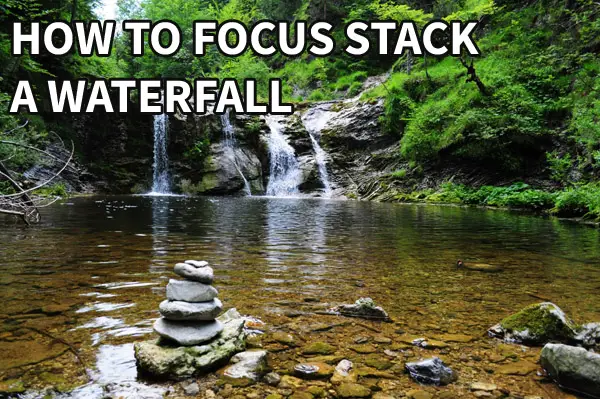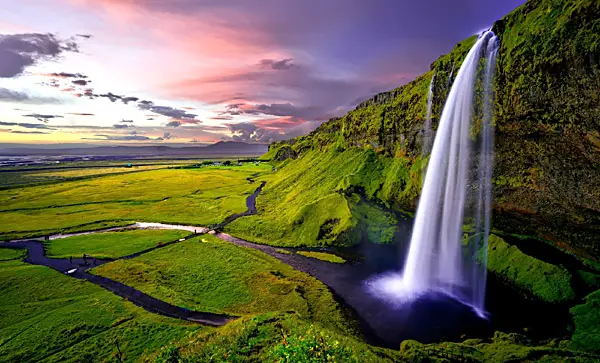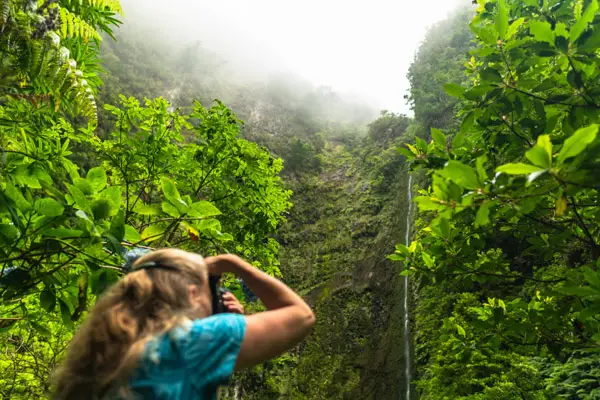When it comes to photographing waterfalls, many people enjoy capturing the majesty of nature in all its glory. Waterfalls are stunning wonders of nature, and there’s something serene and incredible that you simply don’t get with other forms of nature.

However, capturing this beauty does not always come easy, but with some camera adjustments and a little practice, you can learn how to focus stack a waterfall like a pro.
That’s exactly what we’re going to get into throughout this following guide!
To focus stack a waterfall, pick a composition, stabilize your camera, pick fast or slow shutter speed depending on your desired look, and take several photos adjusting the focus slightly after each shot. Then use Photoshop or Lightroom to complete the focus stacking process. Read on to learn more.
What is Focus Stacking?
Focus stacking is a technique used in photography to increase the depth of field in an image. This is done by taking multiple photos of the same scene, each with a different focus point. The photos are then merged together using software to create a photo with a greater depth of field than could be achieved in a single shot.
Basically, focus stacking is a photography technique that you’d use to create an image look that you deserve. According to Adobe, this technique has a goal of capturing a photo of as many in-focus slivers as possible.
You’ll need to adjust the focus ring on the lens so that objects at various distances from it are in focus. During this adjustment, some parts of the subject may be sharp and others blurry. The latter will not come into perfect focus as long as they remain out-of-range for the selected focusing distance.
Focus stacking means you take multiple images with different focal settings then combine them to achieve a final image with an extreme depth of field – all areas appear sharp and crisp.
For example, if you’re photographing bugs on a rock near a waterfall – they’ll most likely end up being out of focus due to their small size relative to your composition’s overall scale. So, you’ll need to take multiple images of that same bug using focus stacking. By taking photos at different focal depths, you’ll have the subject in perfect sharpness – no matter how much it is located away from your camera!
Why Use Focus Stacking on a Waterfall?
One of the most common reasons photographers choose to use focus stacking is when photographing a scene that does not have enough depth for their needs. This can occur in both landscape and macro photography where there are objects at varying distances from your lens. And yes, photographing waterfalls needs to be spectacular to show off their size and beauty.

While this would seem like an easy fix with digital editing, it’s often much harder to accurately merge photos with different focus points than it is to take the photos in the first place. Plus, waterfalls are always moving, meaning that if you try to photograph them without some sort of strategy, then all you would get is a blurry image or a single split second captured.
This is why many photographers choose to use focus stacking as a way to increase their depth of field while shooting. So, when you can’t get a good photo of a waterfall optically, focus stacking can help you get the job done.
How to Focus Stack
So, if you want the waterfall to be captured really well in your photography, then listen up! It’s time to learn how to focus stack in your waterfall photography!
The truth is, there are a few ways that you can go about focus stacking, but the most common is by using a tripod and taking multiple shots of the same scene at different focal points. You’ll want to make sure that your camera doesn’t move between each shot, so using a tripod is essential.
If you’re not comfortable using manual settings, some cameras have an automatic mode specifically for focus stacking. All you need to do is set your camera to this mode, compose your photo, and then let the camera take photos with different focal points.
However, manual settings on a camera will give you more control over your images and they look, thus giving you the final image that you actually want to create. Therefore, it’s highly recommended that you stick to learning and mastering the art of using manual focus. Once you have a series of images, it’s time to use focus stacking software like PhotoShop or Lightroom.
These programs will do all of the heavy lifting for you by aligning each image and merging them together into a single photo that has an increased depth of field. You’ll want to make sure not to move your tripod while taking these shots so that everything lines up correctly in post-processing!
Setting Up Your Camera
There are two major camera settings. As such, most camera operators will want to adjust their settings before capturing a photo with water in it. These camera settings include the focus setting and shutter speed, which is crucial when you’re photographing moving water, waterfalls, rivers, or cascades of any kind!
To focus stack a waterfall, you’ll want to set your camera on manual focus and then use Live View to zoom in as close as possible to the water. Once you have the camera focused on the running water, take a picture, and then adjust the focal length just slightly. Before taking another picture, reviewing the photo taken is crucial. Then, repeat this process until you have enough pictures to create a focus stack. Take more photos than you need to.
If you want the water to be blurry in your stack and reflect motion, but have the other elements of the photo in excellent focus, repeat this step this time changing your shutter speed to 1 second or so. Be extremely careful about stabilization of camera since you are doing slow shutter speeds.

When you’re ready to start stacking your photos, you can use your preferred software. Fortunately, as mentioned earlier, there are two popular software that you can use to focus stack your photos: Photoshop and Lightroom.
Focus Stacking in Photoshop
If you’re using Photoshop, open all of the images you want to stack and then go to File > Scripts > Load Files into Stack. A dialog box will appear where you can select the files you want to stack. After selecting the files, click on OK, and Photoshop will automatically align and blend the photos for you!
You can also choose to focus stack a waterfall using Photoshop’s camera raw tool. In the camera raw window, go to Edit > Stack Mode and select either Mean or Median from the drop-down menu. If you use Mean, your photos will have more of an HDR effect because it blends all of the images together for better contrast and color. Median, on the other hand, will blend your images together without any increase in contrast.
Apply needed filters and adjustments to your first image such as color correction, sharpening, exposure. Then make sure you copy all the changes to the other images in the series you are focus stacking.
If you want to have some areas of the photo be blurry specifically, create a layer mask on that layer, paint it with a brush, and apply a blur filter.
Focus Stacking with Lightroom
“If you’re using Lightroom to stack your waterfall photos, things are a little bit different. After importing all of the images into Lightroom, select them all and then go to Photo > Edit In > Merge to Panorama in Photoshop. This will open all of the images in Photoshop where they will be automatically aligned and blended together!” explains Josh Harper, a photography writer at Research paper writing services.
After the photos have been stacked, you can then export them as a JPEG or TIFF file.
To learn more on how to focus stack waterfalls with both Photoshop and Lightroom, The Phlog Photography has a tutorial on how to make the best out of this technique with both software:
Other Ways to Shoot a Sharp Waterfall
If you aren’t interested in learning how to focus stack a waterfall, there are other ways to capture photos with multiple focal points. One way is by using the camera’s burst mode and setting it to continuous shooting mode. This will allow your camera to take pictures as quickly as possible, which can make for some cool-looking cascades when looking at them in playback mode.
Another alternative to focus stacking to consider is using hyperfocus. By taking a photo of a waterfall using hyperfocus distance, you’ll get a reasonably sharp take of your subject.
Focus Stacking Long Exposure
Waterfalls can also be a great subject for long-exposure photography. In order to achieve the desired effect, you’ll want to use a tripod and set your camera on manual mode. Your shutter speed will then need to be set anywhere from .05 seconds up to several seconds or even minutes, depending on how much blur you want in the scene.
When capturing a waterfall in long exposure, use an ND filter so that your camera doesn’t overexpose the photo with such a slow shutter speed.
Choosing Your Focal Length
Another important tip to remember: Focal length is crucial to focus stacking.
You can choose from several different focal lengths when photographing waterfalls. In actuality, around 24mm to 70mm works best. This gives you a good range of focal lengths to work with and also allows you to get close enough to the waterfall without getting too close!
Waterfall Photography Tips
Now that you know how to focus stack a waterfall, it’s time to put your new skills into practice! Here are some tips for taking great waterfall photos:
– Use a tripod: This is essential equipment for waterfall photography, as camera shake can ruin your photos.
– Use a polarizing filter: A polarizing filter will help reduce glare and reflections on the water’s surface, giving your photos a more polished look.
– Shoot in RAW: This will give you more flexibility when it comes to editing your photos.
– Use a high number aperture: This will help you to get more of the waterfall in focus.
– Shoot during the golden hour: The light during this time is especially beautiful and will give your photos an extra boost of color.
– Shoot in manual mode: This will give you a lot more control over your camera settings.
– Experiment with camera motion blur: If you want to capture running water, this is an easy way to do it!
By following these tips, you’ll get the hang of focus stacking, even after taking great photos of waterfalls.
Experience is Everything
And with that, you should now be familiar with everything you need to know when it comes to photo stacking waterfall, but of course, this is all theory. You’ll get the best experience but putting this information into practice and trying it out for yourself.
So, why not give focus stacking a try the next time you want to get a good picture of a beautiful waterfall? Try several approaches of focus stacking and see what works best for you. Take your time, and don’t be afraid to think outside the box. This is how you’ll be able to figure out what works best for you and will ultimately produce the best photos you can.
Check out our article on manual vs automatic focus stacking.








